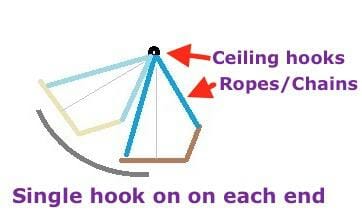
*This post may contain affiliate links (#ad) for which I earn commissions.*
How to Hang a Porch Swing From a Ceiling-Install Guide 2025
Here's a guide on how to hang a porch swing from a ceiling properly and safely creating a special place for reading, relaxing and enjoying yourself.
Here’s a guide on how to hang a porch swing from a ceiling properly and safely creating a special place for reading, relaxing and enjoying yourself. Chose between rope or chain, and whether you want a single or double hook configuration for hanging the swing.
Important! Please use this “checklist install guide” on how to hang a porch swing from a ceiling before buying your porch swing. You need to complete 4-steps before buying your swing.
1. Finding a Safe, Secure Spot for Your Porch Swing
You need to have a strong ceiling frame to support your swing.
For example, a two-person swing needs a minimum of any of the following:
- a single 2 x 8 joist
- two 2 x 6 joists
- three 2 x 4 joists.
All the joists must be securely supported at both ends to bear the load. When you get your swing, follow the installation instructions provided by the manufacturer.
2. How to Choose the Right Supporting Hardware
It’s best to choose anchoring hardware, chains, ropes, and connections that can withstand weather exposure and support a working load of 500 pounds or more. It’s important that the chains or ropes, their attachments and the ceiling support should be strong enough to hold the swing, the maximum weight of people on the swing must be multiplied by two or more to account for the moving load.
Hanger kits will most likely include some nice swivel-type hanger mounts along with heavy-duty springs for a smoother swing. Most kits provide lag screws to hang the swing from the ceiling.
If you’re not using a kit use galvanized or stainless steel heavy-duty bolts, eyes or hooks that have an enclosed ring or hook on one end to attach the swing’s ropes or chains.
Screw-in anchors that are 1/2 inch in diameter with 4-inches of threaded shank are best for anchoring directly into the joists.
Machine bolts at 1/2 inch are best for anchoring to a beam or 4 x 4 blocking installed between joists. The bolts should go all the way through the support beam where they are anchored on the top with a washer and nut.
3. Use Quality Chains or Ropes
Your new swing will most likely come with a rope or chain. Either way, they should be rated for at least 500 pounds of working load. It’s important that the attachments you use, chains or ropes along with the ceiling supports should be strong enough to hold the swing along with the maximum weight of the people. Take the weight of the swing plus the total maximum weight of people that can use the swing and multiply by two or more to account for the moving load. It should be at least 500 pounds.
As with your bolts, chains should be either galvanized or stainless steel.
Ropes should be marine-grade braided nylon or polyester to weather outdoor exposure. Also, ropes will last longer and swing better if there’s an S-hook between the hanging hook/eye and the rope.
Single Hook Configuration

A single hook on each end of the seat will make the seat swing perpendicular to a line that extends from the center of the seat to the hook in the ceiling.
Double Hook Configuration

Two hooks on each end of the seat will track differently depending on the length of the chain and the relative position of the ceiling hooks.
This configuration will not work if the space between the ceiling hooks is much wider than the space between the swing attachments. Chain length for each side must be perfectly matched so the seat is not angled forward or backward.
Hook Configuration Source: bib via stockexchange
4. Measure Swing Space and Hanging Distance
For the swing space, give yourself at least 3 to 4 feet of space behind the swing. Some folks say 2 feet. It’s always good to go with the larger space if you can. Side clearance on each side of the swing can range from 14-inches to 16-inches.
The hanging distance of ceiling anchors should be installed 2 to 4 inches wider than the swings length. For example, if you have a 48-inch wide swing, the ceiling anchors should be 50 to 52 inches apart. This hanging distance provides equal weight distribution an prevents the chains from chaffing against the swing.
5. Researching and Buying Your Swing
Now that you know the measurements of where the swing can go and hang safely from the ceiling, it’s time to go shopping for your swing. Look for a swing that matches the look and feel of your home.
You may find a good deal on a swing but it’s not the right color. You always have the option to paint it the color you want.
Best rated selection of porch swings from Amazon #amazon ad (link opens new window)
6. Finding Joists for the Ceiling Anchors
Calibrate the stud finder against a part of the ceiling where there are no joists. The base reading will now be hollow, not solid.
Two options for when the joists aren’t big enough:
(note: these two options require setting up from within the attic. It’s possible to cut a single hole in the ceiling finish that will allow you to pop up through and then patch up the hole when you’re done. )
Option 1:
- Cut two 4 x 4’s beams so they will run perpendicular across three or more joists.
- Make sure each beam is centered over the swings ceiling hook anchors.
- Secure the beams to the joists with 3-inch screws. It’s best to angle the screws through each side of the beam and into the top of the joists.
Option 2:
- Use lumber blocking by installing (4 each) joist hangers for two 4 x 4’s between two adjacent joists, so the blocking is flush with the bottom of both joists.
- Mark the spot where the swing ceiling anchors would be on one joist.
- Using a framing square, transfer the marks to the neighboring joists.
- Now attach the joist hangers on the inside of the joists, making sure they will face each other. (Follow the manufacturer’s recommendations for installing the joist hangers.)
- Position the hangers so the blocking will be flush with the top of the ceiling finish and centered over where the swing will be anchored.
- Cut two pieces of 4 x 4 that will fit snug into the hangers between the joists. Fasten the blocking to the hangers with hanging nails or screws through the provided joist hanger.
7. Install the Ceiling Hangers
Using the mount mark a the place to drill a pilot hole make sure the drill bit is the size of the screw shank, not the threads. Now thread the eye hook by hand until it’s starts getting difficult, then use a wrench or pliers to turn the screw until all the threads have been screwed into the lumber-usually when you can’t see the threads anymore.
If you have a Hanger Kit with lag screws, the swivel mounts must run parallel to the length of the swing and be mounted in the center of joist or beam.
8. String Up the Swing
Follow the manufacturer’s instructions for hanging your swing.
Tips for hanging with chains:
- Hanging with chains requires two chains. One long and one short for each end of the swing.
- Secure one end of each chain to the front of the swing. If your swing has no hardware use an eye bolt.
- Secure the short chain to the rear of the seat. Then connect the two short chains to their long chain brother-this is a “chain” family affair. You may need to play with this, but 2 to 3 feet above the seat is the sweet spot. Hook the chains together using S-hooks or quick links.
- With a few folks to help you, hook the long chains onto the ceiling hangers. The short chains will pull backward on the long chains making the seat tilt back for comfort.
- Adjust the tilt and height by hooking onto different links. As a rule of thumb 17 to 19 inches above the ground.
Tips for hanging with rope:
- Use a single rope for each side.
- Fold the rope in half. With the folded middle tie a simple overhand knot about 2-inches from the folded middle to create a 2-inch long loop. Hook each loop over the ceiling screw hook. If you have a screw eye just add an S-hook between the eye and the rope loop.
- Prop up the swing on cardboard boxes so it’s level and set the height a little higher than what you want so when you sit on the swing the slack from the knots will set the swing to the desired height.
- Push the end of the rope through the front of the swing and make an overhand knot that’s big enough to keep the rope from slipping through the hole, especially when swinging.
- Remove the boxes and tie off the rear halves on the swing so the swing back is at the desired angle. Again, you may want to set the angle a little tight so when you sit on the swing the slack from the knots will set the angle just right.
- The best part! Have a sit and give yourself a swing. Adjust the knots to make the swing comfortable. You can leave the excess ends or just trim them off.
Now it’s time for some swinging joy!




